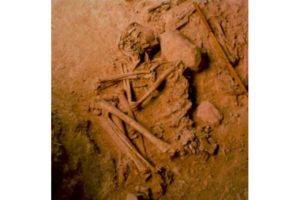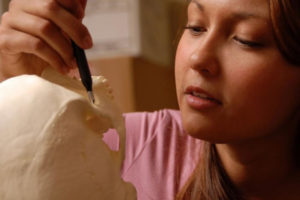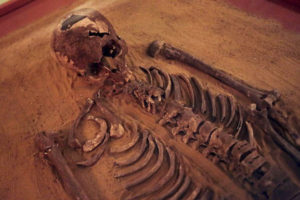November 2014. The European Space Agency’s (ESA) Philae landing craft—which has completed the nearly impossible task of landing on a 34,000 mile per hour comet after a four billion mile, ten-year-long chase through deep space—is testimony once again to the European peoples’ unsurpassable intelligence, skill, engineering, and scientific knowledge.
The landing, which is as awe-inspiring as the moon-landings of more than thirty years ago—another incredible feat of exclusively European technology—has captured the world’s imagination, but all of the controlled mass media’s coverage has deliberately ignored the reality that the entire project, from beginning to end, is the product of the European race’s unparalleled ability to achieve the nearly unbelievable.
The landing means that European-made craft have now landed on seven bodies in space: the moon, Mars, Venus, Saturn’s moon Titan, two asteroids and comet Tempel-1.
The ESA spacecraft Rosetta has been approaching comet c67P for the past few months, and recently descended into near orbit—just six miles away, or as far away as a small jet aircraft flies above the Earth.
The mission was designed more than 20 years ago: the journey has taken just over 10 years, covering a distance of four billion miles—that’s a million times the distance to the center of the Earth, or the equivalent of eight thousand return trips to the moon.
The journey included no less than three passes of the earth—at different locations in the universe—and one pass by of Mars, each time using those planets’ gravitational fields to gain a boost in the direction of the comet.
Rosetta deployed two solar panels—each the size of four cars—to provide power for the decade-long flight.
While traveling through deep space, Rosetta has studied two planets, two comets, and two asteroids, providing scientists back in Europe with a treasure trove of data—even before it achieved the objective of finally catching up with c67P. This trip also included a “hibernation period” consisting of two and a half years to conserve energy.
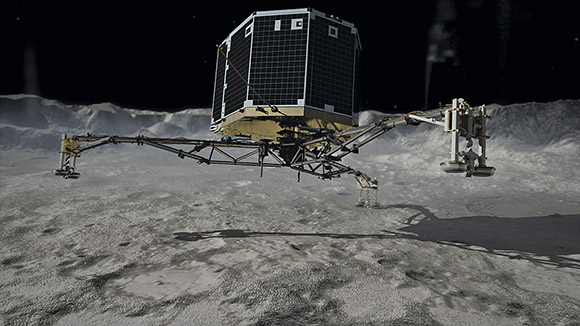

The European-wide effort is apparent from the contributing scientific instruments on board the mission:
The Austrian Space Research Institute developed the lander’s anchor and two sensors within the MUlti-PUrpose Sensors for Surface and Sub-Surface Science (MUPUS) instrument, which will measure the density, thermal and mechanical properties of the comet’s surface).
While the University of Münster built MUPUS, it was designed and built in the Space Research Center of the Polish Academy of Sciences.
The French Space Agency together with some scientific laboratories (IAS, SA, LPG, LISA) provided the system’s overall engineering, radio communications, and battery assembly; the COmet Nucleus Sounding Experiment by Radiowave Transmission (CONSERT) equipment which will use electromagnetic wave propagation to determine the comet’s internal structure.
The Swiss Center for Electronics and Microtechnology developed the Comet Nucleus Infrared and Visible Analyzer (ÇIVA), which is a group of six identical micro-cameras that take panoramic pictures of the surface and which contains a spectrometer to study the composition, texture and albedo (reflectivity) of samples collected from the surface of the comet; and the ground segment (overall engineering and development/operation of the Scientific Operation & Navigation Center).
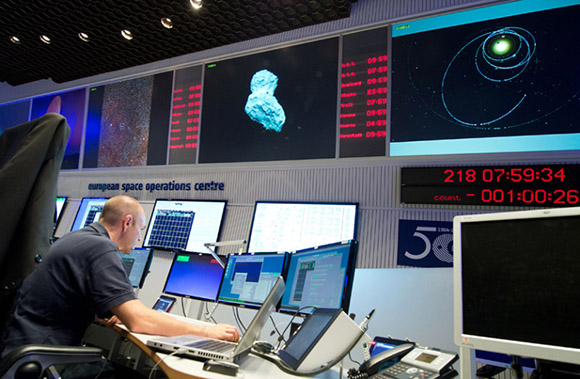
The German Space Agency (DLR) has provided the structure, thermal subsystem, flywheel, the Active Descent System (procured by DLR but made in Switzerland); the Rosetta Lander Imaging System (ROLIS), the downward-looking camera; and the Surface Electric Sounding and Acoustic Monitoring Experiments (SESAME) which will use three instruments to measure properties of the comet’s outer layers. It has also managed the project and undertook the level product assurance.
The Braunschweig University of Technology built the Rosetta Lander Magnetometer and Plasma Monitor (ROMAP), which is a magnetometer and plasma sensor to study the nucleus’s magnetic field and its interactions with the solar wind.
The Max Planck Institute for Solar System Research made the payload engineering, eject mechanism, landing gear, anchoring harpoon, and central computer; the COmetary SAmpling and Composition instrument (COASC), a combined gas chromatograph and time-of-flight mass spectrometer which will perform analysis of soil samples and determine the content of volatile components; and the Alpha Particle X-ray Spectrometer (APXS) which detects alpha particles and X-rays, and will provide information on the elemental composition of the comet’s surface.
The Command and Data Management Subsystem (CDMS), which is the fault tolerant central computer of the lander, was designed in the Wigner Research Center for Physics of the Hungarian Academy of Sciences.
The Power Subsystem (PSS), which assured that the power coming from the batteries and solar arrays were properly aligned, controlled the battery charging and managed the onboard power distribution, was designed in the Department of Broadband Infocommunications and Electromagnetic Theory at Budapest University of Technology and Economics.
The Finnish Meteorological Institute provided the Memory of the CDMS system and the Permittivity Probe (PP) which will investigate the electrical characteristics of the way that sound travels through the surface of the comet.
The Italian Space Agency (ASI) has provided the Drill, Sample, and Distribution subsystem (SD2) which will obtain soil samples from the comet at depths of 0 to 230 millimeters (0.0 to 9.1 in) and distribute them to other subsystems for analysis; and the Photo Voltaic Assembly. The industrial contractors are respectively Tecnospazio SpA and Galileo Avionica SpA.
Space Technology Ireland Ltd. at Maynooth University has designed, constructed, and tested the Electrical Support System Processor Unit (ESS) for the Rosetta mission. ESS stores, transmits, and provides decoding for the command streams passing from the spacecraft to the lander and handles the data streams coming back from the scientific experiments on the lander to the spacecraft.
The Moog Bradford, based in Heerle, the Netherlands, provided the Active Descent System (ADS) that is intended to provide the required impulse to ensure that Philae descended toward the nucleus of the comet. To accomplish the ADS, a strategic industrial team was formed with Bleuler-Baumer Mechanik in Switzerland.
The Open University and the Rutherford Appleton Laboratory (RAL) developed the PTOLEMY system, an instrument used to measuring stable isotope ratios of key volatiles on the comet’s nucleus. RAL has also constructed the blankets that keep the lander warm throughout its mission. Surrey Satellites Technology Ltd. (SSTL) constructed the momentum wheel for the lander. It stabilized the module during the descent and landing phases.



